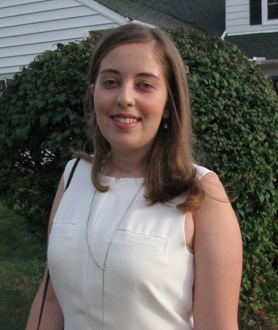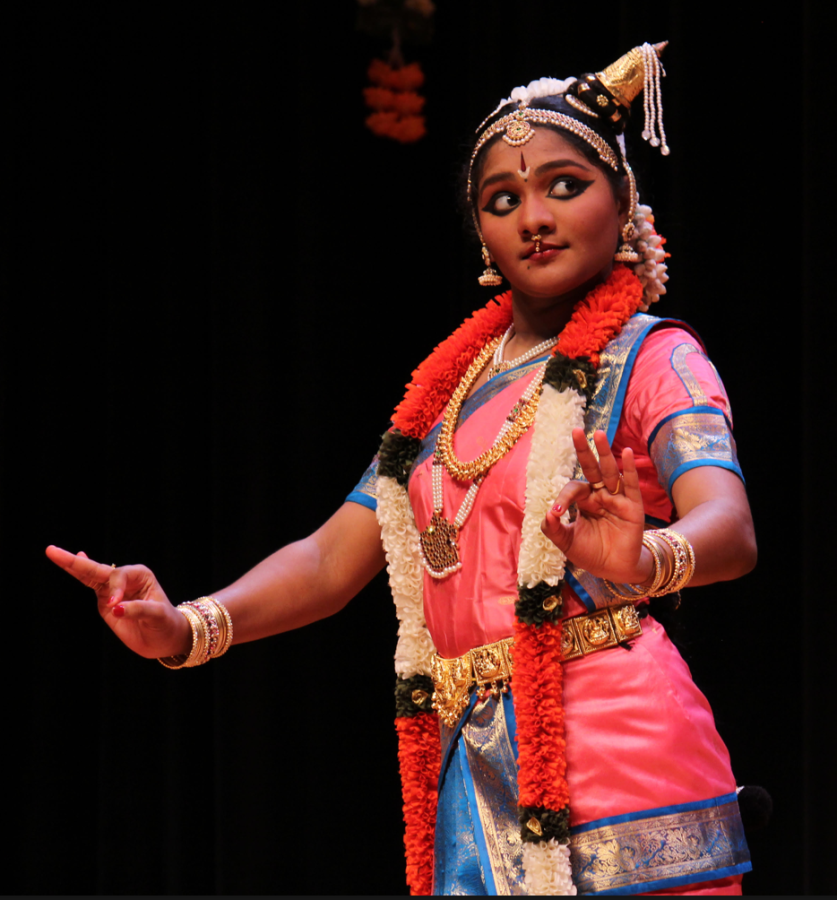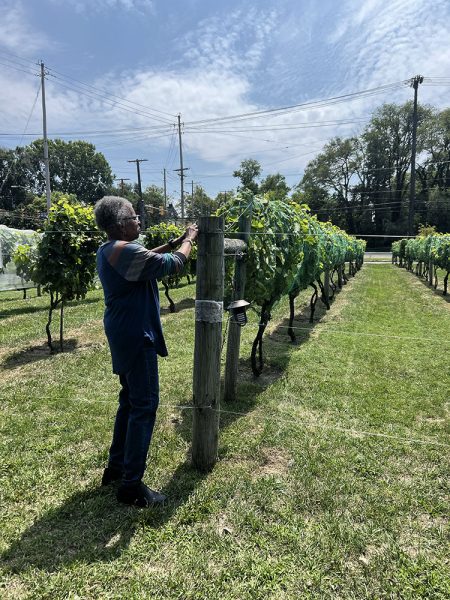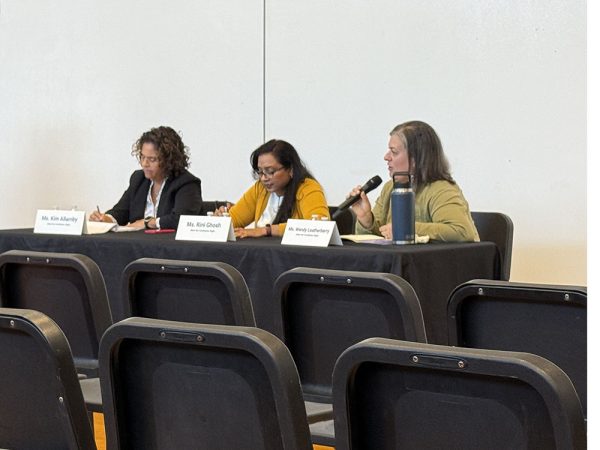Swathi Srinivasan Stuns With Classical Indian Dance Performance
Bharathanatya Arangetram demonstrates mastery of traditional Hindu dance.
Walking into the small lobby of the auditorium at Cuyahoga Community College’s Metro Campus on Saturday, June 27 was like being transported to India.
The room was packed with South Asian families gathered in small groups, speaking unfamiliar languages. Women wore colorful saris, while men wore familiar business casual attire.
The crowd had gathered to celebrate junior Swathi Srinivasan’s Bharathanatya Arangetram, a ceremonial performance demonstrating her mastery of classical Indian dance.
Pictures of Srinivasan were displayed on tables and hung from support beams.
Directly in front of the door was a table full of candles; to the left of that was a sign-in book and a stack of glossy programs.
Many people, American and Indian, were crowded in this space.
According to Rekha Srinivasan, the dancer’s mother, this event took years to plan.
“Financially we had to plan for a few years as it is expensive to bring musicians from India and host them,” she said. “We had to get the costumes done in India.”
“The jewelry [Swathi] was wearing is called Temple Jewelry,” she added. “[It is] completely handmade in silver and ruby spinel with gold foil hand laid on top.”
The invitations and brochures were also printed in India.
In preparation for the performance, Srinivasan had to build up her stamina by eating balanced food with lots of protein, especially since she is a vegetarian.
Srinivasan had withstood ten years of practice. Now she would dance for two and a half hours, changing costumes three times.
In the lobby, cameras flashed through the din of English and various Indian languages.
Then the crowd was directed into the auditorium to witness Srinivasan perform her traditional Hindu Bharathanatya Arangetram.
“Classical dance and music in India has a huge devotional component,” said Rekha Srinivasan, the dancer’s mother. “Swathi depicted stories from Hindu mythology. Dance and singing are also ways of expressing love and devotion to god in addition to prayers, chanting and worship.”
Even in India, these events are rare accomplishments, she explained.
“It takes many years of training and dedication,” Rekha said. “So very few have the talent and work ethic to get to that stage.”
This was not Srinivasan’s first performance, however.
”
Arangetram literally means “to ascend the stage” in Tamil, one of India’s many languages. An arangetram is performed when an Indian dance student has truly mastered this form of classical Indian dance. This performance is the student’s debut to the stage as a classical Indian dancer.
The type of Indian classical dance that Srinivasan performed is Bharathanatyam. According to the program given to audience members, it is the most popular type of classical Indian dance.
“The three syllables ‘Bha ra ta’,” the program states. “Represent the three quintessential aspects of Bhava (expression), Raga (melody) and Tala (rhythm) of the dance form.”
The dancer portrays many split characters during their Bharathanatyam dance. Srinivasan portrayed each by switching roles through the swift turn in circle and creates a story line that can be easily followed. The characters are then portrayed through the narrative of the song and expression, or abhinaya.
Another part of the Bharathanatyam dance is the element of nrtta, meaning rhythmic dance movements. Throughout Srinivasan’s dance, every one of her movements were choreographed, each hand movement and every head turn was in a precise order that had to be followed. Srinivasan exhibited immense concentration and discipline through the entire arangetram.
“It took time to be aware of every movement I was doing,” Srinivasan said. “That took years of mastering steps and emotions.”
Mastering each expression was a challenge, according to Srinivasan’s teacher, Guru Sujatha Srinivasan who trained in India with other illustrious gurus.
“I had to work with her [to make sure] she [was] expressing properly,” she said. “It takes a while to master that part of it. It’s like ivory, you keep polishing and perfecting [it].”
“I had to portray various characters, yes,” Srinivasan said. “But to play such intricate characters, I had to feel their emotions and watch scenes [from movies] and read books to understand them.”
The performance began with a prayer, performed by five musicians sitting on stage right. Srinivasan was not yet on the stage, in order to give the audience their full attention to the musicians and the prayer.
After the prayer was completed Srinivasan entered on stage left and began with the Nrtyanjali. In this passionate and precise dance, the dancer offers flowers to Lord Nataraja, her teacher and the audience.
The fourth dance that Srinivasan performed was the Varnam: Nanda Gopalanai. The Varnam dance is the crown jewel in any arangetram performance simply because it is the longest and most complex dance that was performed that evening. Srinivasan danced without pause for more than 30 minutes, depicting Lord Krishna’s long life.
“[It was] very exciting,” Srinivasan said. “There was a small moment right after I finished that the tiredness hit me, but that was the dress change and I had to snap out of it.”
Chemistry teacher Kim Peoples was also present for Srinivasan’s performance and later offered her perspective.
“I have performed ballet, lyrical, jazz, hip-hop, tap and even a little latin and ballroom dance,” Peoples wrote. “This style was nothing like any of those, and yet there are some things common among all forms of dance. Swathi’s facial expressions played a big role on bringing the stories to life, as in all performances meant to convey something.”
Srinivasan identified a combination of factors that make the Varnam so hard.
“Its length,” she said. “And the complexity of the characters you have to portray; [also] the emotions of the plots.”
After another three dances, Srinivasan’s Vaaranam Aayiram and Mangalam concluded the performance. This dance tells the story of Andal who describes to her friends her dream of an elaborate wedding with Sriman NaaraayaNa, the supreme lord.
Peoples wrote that she was enthralled by Srinivasan’s movements.
“I often caught myself watching just her hands or her feet rather than the whole dancer,” she said. “The intricacies of the movement was captivating, right down to the bend of an individual finger or flex of the toes.”
Math teacher Jeff Luce wrote that he was amazed by Srinivasan’s performance.
“The most fascinating part for me was how she was able to give a performance that was not only highly artistic, but also very physically demanding,” he wrote. “The balance, coordination, and strength required to pull it off was impressive. It was a long performance as well, which required a great amount of endurance and a great amount of memorization on [Srinivasan’s] part.”
“[It felt] exhilarating and energizing [to be done],” Srinivasan said. “I felt relieved and proud at the same time.”
According to Sujatha, this dance is a wonderful way to connect with the past.
“It is a great art form,” she said. “A very ancient art form and young ladies like Swathi are a carrier of a tradition from a teacher to a student. They are fortunate to get that training here. These kids are trained in such a manner that they go back to my native place and native city.”
“Swathi is one of the most amazing people I know,” attendee junior Amanda Wasserman said. “She worked so hard for this performance and it payed off.”
Rekha added that she wishes Beachwood could give recognition to dancers.
“I think [Srinivasan] and other dancers who train rigorously and perform as she has done in front of 500 people have truly earned it,” she said. “I wish [Beachwood City Schools] would give athletic letters to dancers.”

Senior Dalia Zullig had been the Online Editor-in-Chief for three years and is now the Editor-in-Chief. She enjoys writing features the most and runs...












